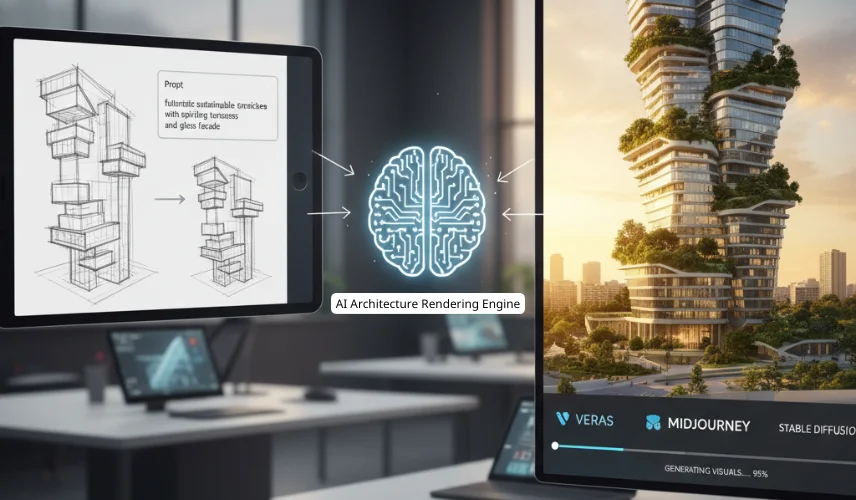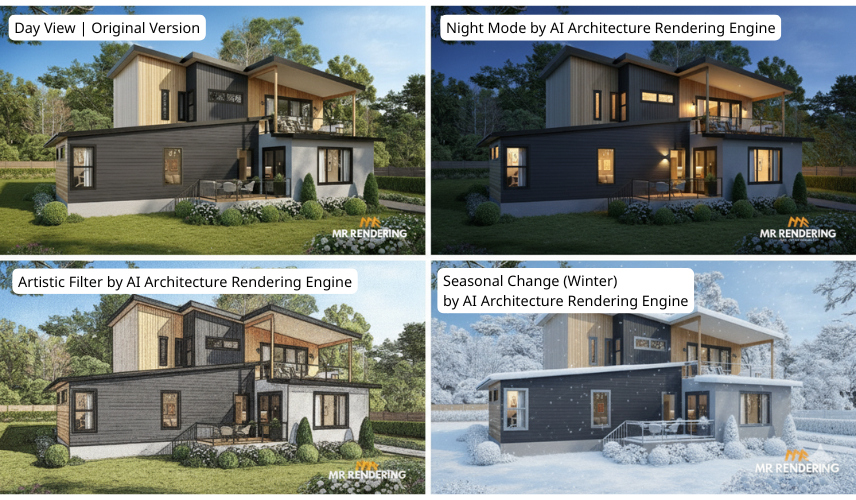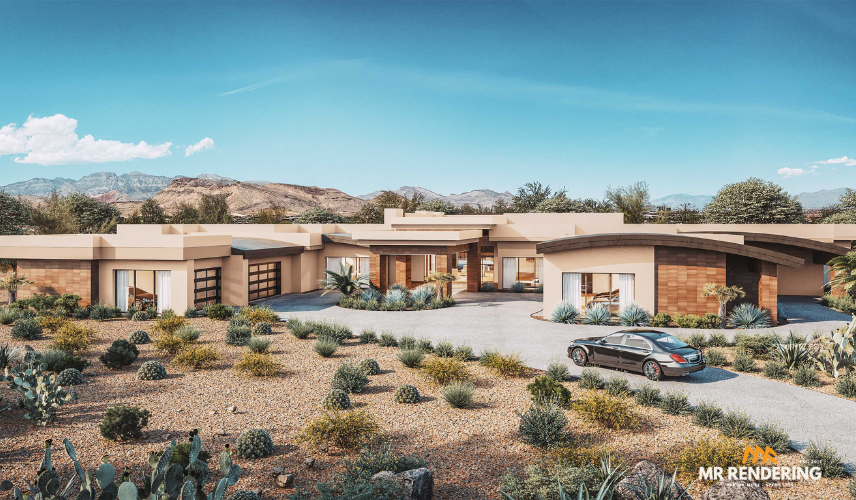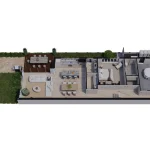
AI Architecture Rendering is the driving force behind the evolution of the architectural visualization industry. For architects, developers, and marketers, this technology offers a transformative way to approach the entire 3D rendering process, from creating initial concepts to perfecting the final visual.
But one question looms large: Will AI eventually replace 3D artists?
Let’s explore the future of AI in architecture rendering – the opportunities, challenges, and why human creativity still plays the significant role.
What Is AI Architecture Rendering?

AI architecture rendering leverages machine learning to generate architectural visualizations from text prompts, sketches, or basic 3D models. Unlike traditional 3D rendering, which requires painstaking manual work in software like 3ds Max, Blender, or V-Ray for modeling, texturing, and lighting, AI automates much of the process. Tools like Veras, MidJourney, and Stable Diffusion (with architectural prompts) enable architects and designers to produce stunning visuals with minimal effort. These AI architectural rendering tools are intuitive, requiring little technical expertise, and are rapidly becoming integral to modern design workflows.
How AI Is Changing Architectural Rendering
AI is no longer a futuristic concept- it’s a practical tool reshaping rendering pipelines in profound ways. Here’s how:
- Generative Design & Concept Creation: AI tools excel at producing quick design sketches or massing models. Architects can input a simple prompt like “modern glass office building” and receive multiple design variations in seconds. This allows for rapid exploration of ideas, enabling architects to test diverse concepts without investing hours in manual modeling.
- Rendering Speed: AI-powered denoising and real-time rendering drastically reduce computation times. Tasks that once took hours- such as rendering high-resolution images with complex lighting- are now completed in minutes, meeting tight project deadlines.
- Post-Production Enhancements: AI streamlines post-production by automating repetitive tasks. It can upscale image resolution, refine lighting and shadows, adjust colors to evoke different moods (e.g., day vs. night), enhance textures like glass, metal, or concrete, and even replace backgrounds or skies instantly. This frees artists to focus on creative decision-making rather than tedious touch-ups.

By automating these processes, AI empowers architects and 3D artists to prioritize storytelling and design intent, making workflows more efficient and impactful.
The Advantages of AI in Architectural Rendering
AI brings transformative benefits to architectural rendering:
- Speed & Efficiency: AI generates high-quality renders in a fraction of the time required by traditional methods, enabling architects to meet tight deadlines without compromising quality.
- Cost Reduction: By minimizing man-hours, AI lowers production costs, making professional-grade rendering affordable for smaller firms and independent designers.
- Design Exploration: AI’s ability to produce multiple design variations quickly encourages creative experimentation, allowing architects to explore bold ideas early in the process.
- Accessibility: AI tools democratize rendering, enabling non-experts to create impressive visuals without extensive 3D modeling skills. This opens the door for startups and solo practitioners to compete with larger firms.
- Consistent Quality: AI ensures uniformity across renders, maintaining a polished look even when producing multiple visuals for a project.

These advantages make AI architecture rendering software a game-changer, particularly for fast-paced industries like real estate and architectural design.
The Limitations of AI Rendering
Despite its strengths, AI rendering has significant limitations:
- Accuracy Issues: AI-generated renders often lack precision in dimensions or construction feasibility. A visually stunning design may not be structurally viable, requiring human oversight to ensure buildability.
- Lack of Context: AI struggles to incorporate local building codes, zoning regulations, or cultural nuances, which are critical for practical architectural design.
- Generic Outputs: Many AI tools produce repetitive or “style-trapped” designs, lacking the originality and uniqueness that human artists provide.
- Client Trust: Many clients still value the craftsmanship and reliability of human 3D artists, who can interpret nuanced project requirements and build trust through personalized communication.

The 3D artist ensures accuracy in details, contextual relevance, and builds client trust
These shortcomings underscore the need for human expertise to complement AI’s capabilities.
The Pros and Cons of AI in Architecture Rendering
To summarize, AI’s impact on architectural rendering is a double-edged sword:
Pros:
- Faster turnaround times for renders and iterations.
- Lower costs, making high-quality visuals accessible to more clients.
- Consistent quality across multiple renders.
- Rapid generation of design variations to fuel creativity.
Cons:
- Limited originality, as AI often relies on pre-existing patterns.
- Risk of over-reliance on automated outputs, potentially compromising quality.
- Need for human oversight to ensure technical accuracy and aesthetic coherence.
In short, AI is a powerful tool, but it requires the human touch to achieve truly exceptional results.
Will AI Replace 3D Artists?
The short answer is no – AI will not replace 3D artists. While AI excels at automating repetitive tasks like noise reduction, texture enhancement, or mood filters, it cannot replicate the artistic judgment, cultural sensitivity, and storytelling that human artists bring. Clients value the ability of 3D artists to convey a project’s narrative- its purpose, emotional impact, or cultural context-which AI struggles to achieve. Additionally, complex projects demand technical precision that AI tools often fail to deliver. Instead of replacement, AI serves as a partner, speeding up workflows and reducing costs while humans guide the creative vision.

MR Rendering: Blending AI with Human Expertise
At MR Rendering, we’ve embraced AI to enhance our pipeline and deliver better value to our clients. AI helps us refine lighting, materials, and post-production details faster, allowing us to offer competitive pricing without sacrificing quality. Our 3D artists focus on the creative aspects-ensuring every render tells the right story and aligns with the client’s vision. We start with Meshy AI to quickly generate base models from text or image prompts. For more refined assets, Hunyuan 3D produces textured models in formats like FBX or OBJ, ready for integration into Blender or Unreal for polishing. In post-production, we use Magnific to sharpen details and upscale renders, avoiding time-consuming re-renders. Together, these tools free us from repetitive tasks, accelerate delivery, and let our team focus on what matters.
The Future: Human + AI Synergy
As far as 3d visualization is concerned, the future of AI in architectural rendering is about collaboration, not competition. AI acts as a co-pilot, generating initial concepts and variations at unprecedented speeds. Human 3D artists serve as directors, refining AI outputs to ensure technical accuracy, design intent, and narrative coherence. MR rendering’s service is already adopting hybrid workflows, using AI to accelerate early ideation while relying on 3d artist’s expertise for final deliverables. This synergy maximizes efficiency while preserving the artistry that defines exceptional architectural visualization.
Conclusion
AI architecture rendering is a transformative force, offering speed, affordability, and accessibility to the architectural and real estate industries. However, it won’t replace 3D artists – it will empower them. The best architectural visualizations will come from blending AI’s efficiency with human creativity, technical expertise, and storytelling. At MR Rendering, we believe the synergy of AI and human expertise is the key to delivering high-quality, cost-effective, and fast-track 3d rendering.
Ready to revolutionize your architectural visualizations? Experiment with AI architecture rendering tools to streamline your workflow, but always collaborate with talented 3D artists to ensure your renders are both technically sound and creatively compelling. The future is here – embrace the power of AI and human artistry together.

Content Marketing Specialist
Linh Nguyen is a seasoned copywriter and marketing strategist with 15 years of experience in brand building, customer engagement, and cross-functional campaign management. For the past 5 years, she has specialised in the real estate industry, bringing in-depth knowledge of property marketing, buyer psychology, and market trends.







